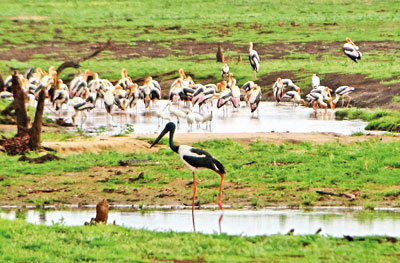Forget the elephants, there’s a Black necked stork!

The Black necked stork at Uda Walawe. Pic by Srilal Miththapala
I was on a quick, and somewhat overdue visit to the Uda Walawe National Park (UWNP) last week with my friend and one-time colleague Ashoka Ranjeewa, now carrying out some research into male elephant behaviour in the park. We had booked the just refurbished Park Bungalow Thim-biriyamankada for an overnight stay.
Since Ashoka has already done some preliminary reconnaissance in the past few days we knew (as most of the trackers did) that most of the elephants were to be found on the eastern side of the park in the Mau-Ara (stream)area. Due to the prevailing drought, the stream had all but dried out, leaving behind a rich mulch where young grass shoots were sprouting. It was obvious that this was what was attracting elephants to the area, somewhat like the phenomena of the Gathering in Minneriya, albeit on a smaller scale.
So the place was a hive of activity with many jeeps, and excited tourists. We had parked on a side and patiently watched the feeding behaviour of the elephants.
As always we had some very good close sightings. There is no doubt that UWNP is the best place to see wild elephants in their natural habitat all year round. My initial studies carried out in 2001/02 under the auspices of the US Fish & Wild Life Services, and the subsequent long term studies done by Dr. Shermin de Silva (de Silva et al. 2011) and Ashoka Ranjeewa, has shown that the park may be having over 1,000 elephants, the highest density of elephants in any wild life park in Sri Lanka. So elephants do take pride of place for any visitor to the UWNP.
As the evening shadows lengthened the influx of jeeps and chattering tourists reduced, leaving us peace and calm. We drove upstream along the dried up river bed, until we could go no further, due to the very muddy conditions. A small body of water ahead had a large number of painted storks together in one melee. I zoomed in with my 300 mm telephoto to get a better shot of this ‘gathering’, when something unusual came across my field of view. It was a large bird with a black head. We quickly forgot all about elephants and trained all our telephoto lenses and binoculars at the spot to make a better identification.
Neither of us could really believe what we were seeing. Slowly we turned to each other and whispered disbelievingly “Black necked stork?” Bird books were quickly retrieved and referred to, and it began to dawn on us that this was indeed a very rare sighting of a Black necked stork.
Now Black necked storks (Ephippiorhynchusasiaticus) are tall, long-necked wading birds in the stork family. It is a large bird, 129–150 cm (51–59 inches) tall, having a 230-centimetre (91 inches) wingspan. The average weight is around 4,100 grams (145 oz) (Ref Wiki). It is said to be the largest of all birds in Sri Lanka.
In Sri Lanka, the species is a rare breeding resident, with only 4–8 breeding pairs seen in Ruhuna National Park. It is classified as Near Threatened (NT) on the IUCN Red List. And the icing on the cake was that from all reports, it had never been sighted ever before in the UWNP. This was subsequently confirmed to me by experts Deepal Warakagoda and Dr. Devaka Weerakoon.
We took whatever pictures we could from that distance, watching for long as we could, until dusk was upon us, and we had to reluctantly retreat back to the bungalow.
We were thankful that UWNP had shared with us this wonderful and unique sight.


